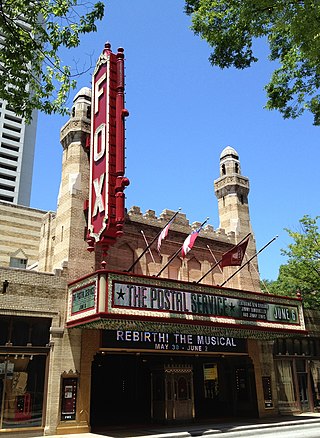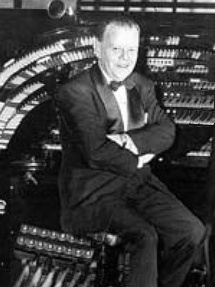
A theatre organ is a type of pipe organ developed to accompany silent films, from the 1900s to the 1920s.

The Fox Theatre, a former movie palace, is a performing arts venue located at 660 Peachtree Street NE in Midtown Atlanta, Georgia, and is the centerpiece of the Fox Theatre Historic District.
An organ recital is a concert at which music specially written for the organ is played.
Reginald Herbert Dixon, MBE, ARCM was an English theatre organist who was primarily known for his position as organist at the Tower Ballroom, Blackpool, a position he held from March 1930 until March 1970. He made and sold more recordings than any other organist before him, or since. He was in high demand throughout the 1930s, 40s, 50s, 60s and 70s. During his fifty-year career he was one of the top-selling artists, his prolific output ranking alongside that of Victor Silvester and Bing Crosby.

The Fox Theatre, a former movie palace, is a performing arts center located at 527 N. Grand Blvd. in St. Louis, Missouri, United States. Also known as "The Fabulous Fox", it is situated in the arts district of the Grand Center area in Midtown St. Louis, one block north of Saint Louis University. It opened in 1929 and was completely restored in 1982.
George Wright was an American musician, possibly the most famous virtuoso of the theatre organ of the modern era.

The Paramount Theatre was a 3,664-seat movie palace located at 43rd Street and Broadway on Times Square in New York City. Opened in 1926, it was a showcase theatre and the New York headquarters of Paramount Pictures. Adolph Zukor, founder of Paramount predecessor Famous Players Film Company, maintained an office in the building until his death in 1976. The Paramount Theatre eventually became a popular live performance venue. The theater was closed in 1964 and its space converted to office and retail use. The tower which housed it, known as the Paramount Building at 1501 Broadway, is in commercial use as an office building and is still home to Paramount Pictures offices.

Jesse Crawford was an American pianist and organist. He was well known in the 1920s as a theatre organist for silent films and as a popular recording artist. In the 1930s, he switched to the Hammond organ and became a freelancer. In the 1940s, he authored instruction books on organ and taught organ lessons.

The Paramount Theatre is a concert venue in Denver, Colorado, located on Glenarm Place, near Denver's famous 16th Street Mall. The venue has a seating capacity of 1,870 but is a popular destination for large acts looking for a smaller concert setting. With spelling as Paramount Theater, the building was listed on the National Register of Historic Places in 1980.

Dennis James is an American musician and historic preservationist. Beginning in 1969, he presented historically informed live accompaniments for silent films, with piano, theatre organ, chamber ensemble and full symphony orchestras, throughout the United States, Canada, Mexico and overseas. He is now primarily active as a noted multi-instrumentalist, specializing on Franklin glass armonica and the theremin, prominently performing in New York at the Metropolitan Opera, for Hollywood film scorings, and repeat performances at Lincoln Center's Mostly Mozart Festival plus performing at the Tanglewood Festival with the Boston Symphony Orchestra performing the intricate glass armonica complete part in the U.S. debut of George Benjamin's opera "Written on Skin".

Gaylord Carter was an American organist and the composer of many film scores that were added to silent movies released on video tape or disks. He died from Parkinson's disease.

The Virginia Theatre is a live performance and movie theatre in downtown Champaign, Illinois. It has been providing theatrical and cinematic entertainment to the Champaign-Urbana community since its doors opened in 1921. Each year, the Virginia Theatre is host to movies from film reels, plays from various acting troupes, concerts, and Ebertfest, presented by the UIUC College of Media. It is currently owned by the Champaign Park District.

Rosa Rio was the stage name of American concert pianist Elizabeth Raub, who also provided scores and arrangement for theater, radio, television and film productions later becoming a teacher of music and voice. She started her career as a theatre performer before becoming a silent film accompanist, after which she became a leading organist on network radio and television for soap operas and dramas. In 1993 she reprised her film accompaniment career in Florida, providing the scores for early productions, some of which she had accompanied some 80 years earlier, on their release to cinema.

Bernie Anderson Jr. is a silent film music composer, organist and orchestrator. He has presented live accompaniments for silent films, with theatre organ and piano since 1995. He is also active in the preservation and restoration of Movie Palaces, Theatre organs and Classic Film.
Walt Strony is an American recording, consulting and performing organist and organ teacher, both on the theatre organ and traditional pipe organ, ranging from pizza parlors to churches and theatres to symphony orchestras.
Pearl White was an American silent-era theatre organist and piano player who worked in the Chicago area.

Martin Ellis is an American church, concert and theatre organist. He is currently the organist for Rose City Park Presbyterian Church in Portland, Oregon. He was Principal Organist and Assistant Music Director at North United Methodist Church, and Senior Staff Pianist/Organist, Staff Arranger and Orchestrator for the Indianapolis Children's Choir and Youth Chorale in Indianapolis, Indiana until August, 2014. He works with Gresham High School's Theatre Arts Department as their resident piano accompanist.
Lee Orville Erwin was an American theatre organist who played an important part in a revival of interest in the silent film era. His career began as an organist accompanying first-run silent films in the 1920s. He received classical training in Cincinnati and France, and then began a career as organist and arranger for radio, significantly at WLW and CBS Radio, the latter in association with Arthur Godfrey, that lasted through the mid-1960s. When his radio career ended he was commissioned to provide complete new scores for silent films exceeding seventy in number, and in this capacity and as an organist for silent film tours and exhibitions he received widespread critical acclaim. Erwin was active into his early 90s.

Richard William "Dick" Leibert was an American musician who was the chief organist at New York City's Radio City Music Hall between 1932 and 1971. He also had a radio program of organ music on the NBC Radio Network in the 1930s and 1940s, along with making phonograph recordings on the RCA Victor and Westminster Records labels.
















